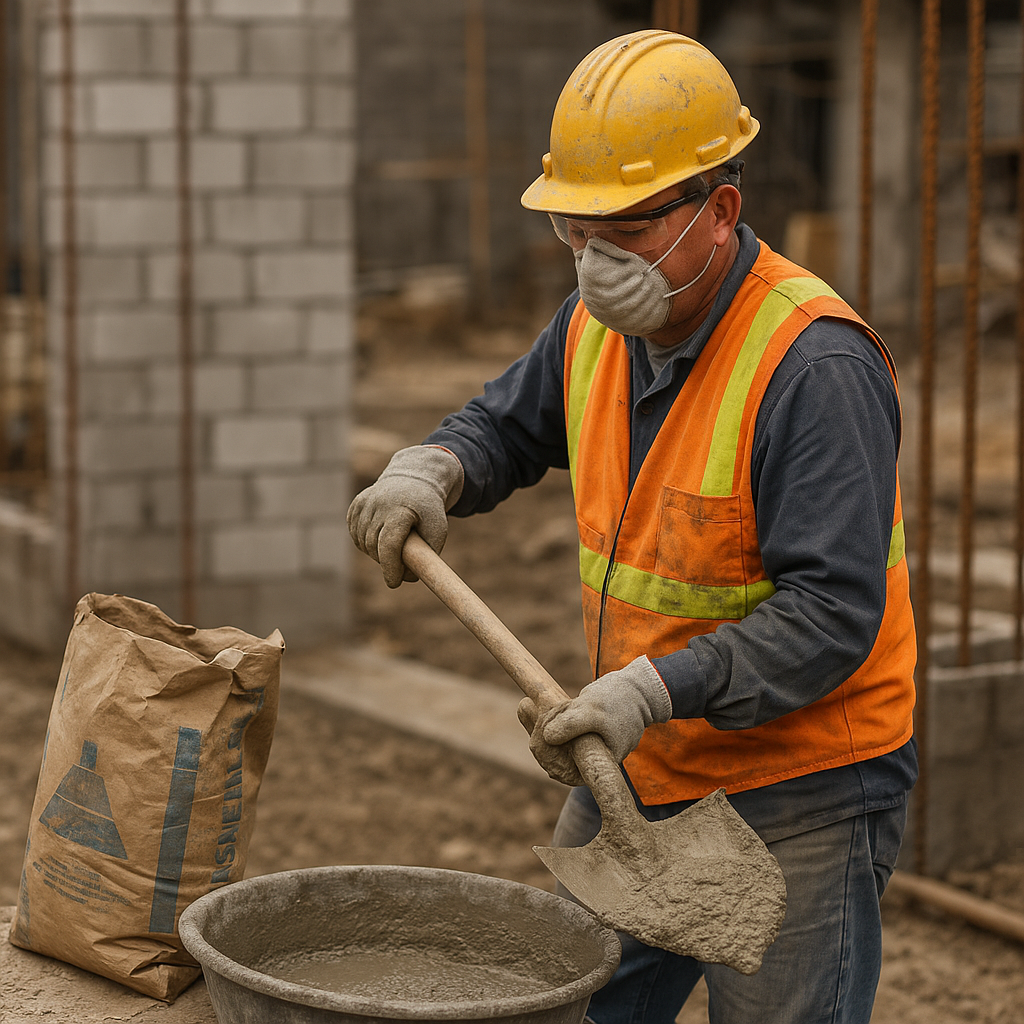Working with cement is a routine part of construction jobs across the globe, but the health hazards of working with cement are often underestimated. At first glance, cement appears harmless—just a dry powder mixed with water and aggregates to form concrete.
However, the chemical composition and physical properties of cement can pose serious health risks to construction workers if proper precautions aren’t taken.

In this article, we’ll dive into the key health hazards associated with cement exposure, explain how these risks affect the body, and offer safety recommendations to protect workers on-site.
Understanding the Composition of Cement
Cement is primarily made of calcium oxide (lime), silica, alumina, iron oxide, and small amounts of other chemicals.
When mixed with water, it undergoes a chemical reaction called hydration, which can produce heat and release alkaline substances. These chemical reactions contribute to most of the health issues associated with cement.
Common Health Hazards of Working With Cement

Skin Irritation and Burns
One of the most common health hazards of working with cement is skin damage. Wet cement is highly alkaline and abrasive, often leading to:
- Irritant Contact Dermatitis: Red, itchy, and inflamed skin caused by repeated exposure.
- Allergic Contact Dermatitis: Resulting from sensitization to substances like chromium present in cement.
- Chemical Burns: Especially when wet cement is trapped against the skin under clothing or gloves.
In severe cases, prolonged contact can lead to cement burns, which may not be immediately painful but cause deep tissue damage.
Respiratory Issues from Cement Dust
Dry cement generates a fine dust that, when inhaled, can:
- Irritate the nose and throat.
- Trigger or worsen respiratory conditions like asthma.
- Lead to chronic bronchitis after long-term exposure.
- Cause silicosis, a serious lung disease, if silica particles are present in the dust.
Repeated exposure to cement dust without respiratory protection can lead to irreversible lung damage.
Eye Injuries
Cement particles or splashes can cause:
- Eye irritation from dust.
- Chemical conjunctivitis due to alkaline exposure.
- Corneal burns from wet cement contact.
Eye injuries may result in temporary or permanent vision loss without prompt treatment.
Ergonomic and Musculoskeletal Injuries
Handling bags of cement, shoveling mixes, and pouring concrete are physically demanding tasks. Common injuries include:
- Lower back strain from lifting heavy materials.
- Shoulder and joint pain due to repetitive motions.
- Fatigue and long-term musculoskeletal disorders from poor posture and improper handling.
Long-Term Health Effects
Chronic exposure to cement without protective measures can result in:
- Occupational asthma and other lung disorders.
- Persistent dermatitis and skin sensitivity.
- Allergic reactions to chromium and other additives.
- Increased risk of certain cancers (e.g., lung cancer) with prolonged silica dust exposure.
These outcomes highlight the importance of early intervention and continuous safety training.
Protective Measures to Minimize Cement Exposure
Personal Protective Equipment (PPE)
Workers should always wear:
- Gloves (preferably nitrile or neoprene) to protect the skin.
- Long-sleeved shirts and pants to reduce skin exposure.
- Goggles or face shields to guard against splashes.
- Respirators or dust masks approved by NIOSH when mixing or working in dusty environments.
Safe Work Practices
- Use wet methods to reduce dust when mixing or cutting materials.
- Wash exposed skin immediately using pH-neutral soaps.
- Change clothes and shower promptly after work.
- Use mechanical lifting aids or team lifting for heavy cement bags.
- Store cement in sealed containers to minimize dust spread.
Medical Surveillance
Regular health checks and skin inspections can help identify early symptoms of dermatitis or respiratory issues. Workers with symptoms should report them immediately and receive appropriate care.
Training and Safety Awareness
Employers have a legal and ethical responsibility to train workers on the health hazards of working with cement. b

Training should include:
- Hazard recognition.
- Safe handling procedures.
- PPE usage and maintenance.
- Emergency response for cement burns or inhalation.
Resources like WorkSafeBC, CCOHS, and OHSE.ca provide valuable information and downloadable safety materials to support ongoing worker education.
Regulatory Standards and Employer Responsibilities
In Canada and the U.S., agencies like OSHA and WSIB have established exposure limits and guidelines for cement dust. Employers must ensure:
- Workplace exposure remains below permissible levels.
- Safety data sheets (SDS) for all cement products are available.
- Proper ventilation is maintained in enclosed spaces.
Non-compliance can result in penalties, legal action, and severe worker health impacts.
Final Thoughts
The health hazards of working with cement should never be taken lightly. While cement is a cornerstone of modern construction, its chemical and physical risks demand serious attention.

By using proper PPE, implementing safe work procedures, and committing to continuous education, construction teams can prevent injuries and protect long-term health.
Remember: Awareness, protection, and prevention are your best tools on the job.

No comments yet